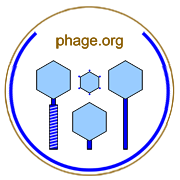

Chapter authored by Stephen M. Krone and Stephen T. Abedon published in 2008.
Krone, S. M. and S. T. Abedon 2008. Modeling phage plaque growth, p. 415-438. In: S. T. Abedon (ed.), Bacteriophage Ecology. Cambridge University Press, Cambridge, UK. [Google Books]
Abstract: The modeling of bacteriophage growth is complicated by spatial structure. Spatial structure, for phages, consists of impediments to environmental mixing, impediments to phage diffusion, and impediments to bacterial motility. A spatially structured environment, however, is perhaps best described by what it is not: a well-mixed, fluid culture. Spatial structure as observed within the laboratory can consist simply of unstirred (or unshaken or not bubbled) broth cultures (Buckling and Rainey, 2002). More commonly, so far as phage growth is concerned, we find bacteriophages growing as plaques within bacterial lawns. Within agar, phages generally are free to diffuse, though not as readily as in broth cultures, while bacteria typically are somewhat immobilized. This spatial structure, in broad terms, replicates the spatial association seen within such naturally occurring microenvironments as biofilms, soil, and sediments as well as the various surfaces associated with plants, animals, and other multicellular organisms. Here we consider the mathematical modeling of phage growth within relatively homogeneous spatially structured environments as approximated by phage plaque formation within a soft agar overlay. We first consider a variety of models that are limited to describing the enlargement of plaques and then additional models that consider other aspects of phage plaque growth. Mathematically, the modeling results we discuss come from reaction–diffusion (RD) differential equations and stochastic cellular automata (CA).
Contact web master. Return to terms.











